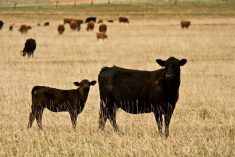There were no sales last week with auction barns closed for the holiday season; therefore, we start the year looking forward at factors that will influence the feeder market over the next month.
While the feeder market was quiet, feedlot operators were surprised with the U.S. fed cattle market jumping US$3-$4 from seven days earlier. On Dec. 28, fed cattle in the U.S. southern Plains traded at US$123 on a live basis and dressed sales in Nebraska were quoted at US$195. It now looks like Alberta fed cattle prices should trade in the range of $161-$165 on a live basis in the first half of January. Breakeven pen closeouts are hovering around $165 (all costs including yardage, feed, et cetera). For March and April, feedlots can forward contract cattle in the range of $168 to $170 so feedlot margins appear to be moving into positive territory.
Read Also

U.S. grains: Soy futures set 15-month high after China agrees to purchases
U.S. soybean futures reached a 15-month high on Thursday after President Donald Trump’s administration said top-importer China agreed to buy tens of millions of tons of American crops in the next few years as part of a trade truce.
Feedlot operators have been fairly aggressive on shorter-keep replacements. In late December, larger-frame tan steers averaging 850 lbs. were quoted at $195 in central Alberta. Forage and feed supplies are rather tight in southern Alberta. We now find feedlots in the Lethbridge area sourcing from farther distances. During January, prices for short-keep yearlings should remain rather firm and move in line with the fed market.
The U.S. slaughter pace has been running sharply above expectations. Fed cattle have been marketed sooner than normal, resulting in lower carcass weights. Should this trend continue, fed cattle supplies will be tighter in the deferred positions. For feeders under 700 lbs., cow-calf operators need to watch June and August live cattle futures, which are currently trading at a $7 and $10 discount to the April contract. Higher-quality 600-lb. steers have been trading around $215 in central Alberta. At this time, these feeders have been bid up so there is minimal margin in the third quarter of 2019.
The first half of 2019 could be a very volatile period for the fed and feeder markets. The beef complex has been one sector which has greatly benefited from U.S. personal tax cuts. Compared to past years, the feeder market will be more susceptible to changes in beef demand. The recent slide in equity and financial markets has cattle markets on the defensive in anticipation of slower consumer spending in the first quarter.
— Jerry Klassen manages the Canadian office of Swiss-based grain trader GAP SA Grains and Produits Ltd. and is president and founder of Resilient Capital, specializing in proprietary commodity futures trading and market analysis. Jerry consults with feedlots on risk management and writes a weekly cattle market commentary. He can be reached at 204-504-8339.












